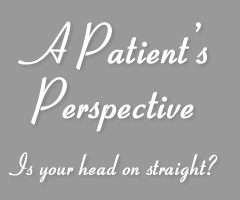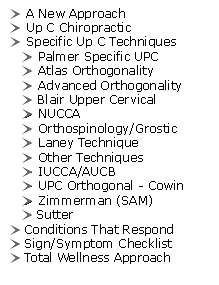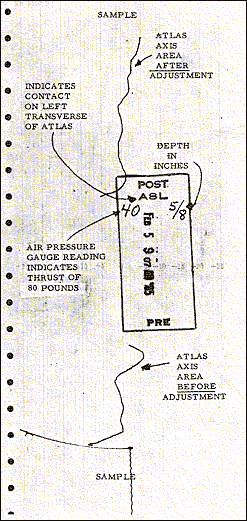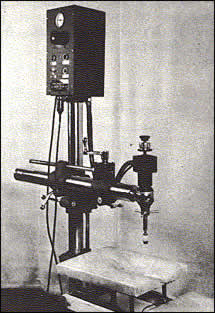

 |
 |
|
Home | A New Approach | Specific Up C Techniques | Zimmerman (SAM) DR. ZIMMERMAN'S "SPECIFIC ADJUSTMENT MACHINE" (SAM) Email: PREFACE Next come the falls of active children -- falls from walls, from ladders, hits from fights, by bats in ballgames, hits by swings -- all too numerous to mention. In adult life, think of the automobile crashes, the accidents in industry, falls on slippery streets -- again too common to mention. Is it any wonder that at sometime in your life, the freely movable atlas-axis vertebrae get misplaced. When this occurs, nerves become caught and compressed, nerves that must function well, from birth (even from fetus) to death if your organs and body parts are to have life, strength, and health to meet the demands of everyday living. This is the very heart and core of the work to which Arden D. Zimmerman is devoted. To the end that he has regained health and that all those who come to him seeking restoration to health may be served. December 15, 1968 Stella Ford Walker [For over ten years Mrs. Walker was engaged in strictly supervised medical research for the top surgeons and medical clinics of the world. She was formerly director of the library and department of literary research of the American College of Surgeons; chief statistician and medical librarian of the Cook County Institutions in Chicago, Illinois.] CHIROPRACTICE
ECONOMICS AN ADJUSTING MACHINE TO CORRECT SUBLUXATION BY
ARDEN D. ZIMMERMAN, D.C. This writer submits that if Chiropractic is to survive it must offer the sick a standardized service of proven value, at the lowest cost possible. This report is offered as evidence that there is no competition for a scientific chiropractic service which removes nerve pressure and stops there. It concerns a carefully planned procedure which the writer has used exclusively since 1948. He has machine adjusted more than 48,000 individuals at this time -- December 1986. Most patients are adjusted on the atlas vertebra; about half are adjusted on the right and half on the left transverse of the atlas vertebra. Very few are adjusted on the spinous of the axis vertebra. Perhaps the most interesting and fascinating part of this story is the way in which the idea of mechanical adjusting catches on with the public. People who have been cared for in this way will travel thousands of miles when they need another adjustment because they have found by experience that it cannot be duplicated by hand. Day after day patients who have been to many chiropractors without getting permanent results come to consult with Dr. Zimmerman. He discusses the problems involved and carefully points out the possibility of spinal cord pressure existing at the base of the skull. Regardless of what else has been done, if a nerve pressure still exists at this point, the patient's condition will remain unchanged. Patients question why all chiropractors don't do this same kind of work -- especially those who have graduated from the same school, and more especially when the patients have had to travel several hundred miles to get a correction made by machine in the upper cervical region. Unfortunately this procedure is not taught in any school. The results of a careful survey of patient's reports will show that regardless of what else was done to the patient by any therapy, manipulation, treatment, etc. unless something was done to the cervical region, the patient had only temporary relief. This, then, indicates beyond argument that unless a standardized program is set up for removal of nerve pressure in the cervical region, the patient will get no permanent results. Arden D. Zimmerman graduated with honors from the Engineering School of Stanford University in June, 1931. He won a two-year scholarship for graduate work in Electrical Engineering. His health had been a constant problem since the age of nine years when he was hit in the back of the head with a swing. A bronze-like skin color developed along with severe prostration, progressive anemia, extremely low blood pressure, hypothermia, loss of weight, diarrhea, digestive disturbance and complete loss of appetite. The medical diagnosis was Addison's Disease; it is usually fatal. By 1932, he had become permanently and totally disabled and was bedridden for about five years. In 1935, his mother directed his attention away from the hopeless medical prognosis to osteopaths, first, and then to chiropractors. After the services of many chiropractors failed to produce lasting results, Mrs. Zimmerman took her son to the B. J. Palmer Clinic in Davenport, Iowa. He arrived there on a stretcher on February 11, 1937. The frequent adjustments made by Dr. B.J. Palmer on the atlas vertebra temporarily removed nerve pressure enabling the patient to become a student there in September of 1937. His recovery was marked by severe ups and downs but by March, 1939, he graduated from the Palmer School of Chiropractic and left the Palmer Clinic as a patient in May, 1939. The problem of permanently removing nerve pressure was never solved for him at the Palmer Clinic. He received his license to practice in California in August, 1939. His first interest was directed to the task of finding a positive method of obtaining X-Ray information about the occipito-atlanto-axial region because a basic study of the full spine reveals that the atlas and axis are the only freely moveable vertebrae. An examination of the occipito-atlanto-axial region will reveal that the atlas and axis vertebrae are in a class by themselves. See GRAY'S ANATOMY, 23rd Edition: Page 279 Articulations of the Vertebral Column "Articulations of Vertebral Bodies (intercentral ligaments). The articulations between the bodies of the vertebrae are amphiarthrodial joints, and the individual vertebrae move only slightly on each other." Page 287 Articulation of the Atlas with the Epistropheus or Axis "This joint allows the rotation of the atlas (and, with it, the skull) upon the axis, the extent of the rotation being limited by the alar ligaments." Page 288 Articulations of the Vertebral Column with the Cranium "The movements permitted in this joint are (a) flexion and extension which give rise to the ordinary forward and backward nodding of the head, and (b) slight lateral motion to one or other side." The atlas can side-slip under the condyles of the occiput. This is the most common displacement. The axis can rotate under the atlas. All the rest of the vertebrae from the third cervical down are provided with locking processes above and below which prevent motion sufficient to put pressure on the spinal cord unless there is a fracture or dislocation. The undeniable proof of this fact is to see so-called ruptured disc cases (even those who have undergone the surgical treatment) attain freedom from pain following one, single, precise adjustment of the atlas (or axis) vertebra. Seldom does a patient come who has not been to chiropractors, osteopaths and M.D.'s who have "treated" the area where the pain is located. These people come with severe doubts that they are doing the right thing, but the results that follow the removal of nerve pressure erase all doubts. They refer their suffering friends and relatives from great distances and, in fact, provide them with transportation and money to get this service. The business of taking care of sick people is very highly competitive. Chiropractors, osteopaths, M.D.'s and hosts of others treat the patient's symptoms for a fee. The program outlined in this article gets sick people well. The fact that there is a steady flow of referrals based solely on results speaks for itself. Only those patients who understand what is being done and give it a chance get results. If a person who has suffered from headaches over a period of time has cord pressure removed, it is not reasonable to expect the headaches will disappear at once. This does happen occasionally but the average case outgrows the symptoms gradually as one would expect in any growth process. The headaches usually become less frequent and less intense as time passes. Instead of gradually growing worse, the process is reversed and the patient gradually grows better. The removal of cord pressure permits recovery to take place. This is no panacea, this is no cure-all; it is a simple straightforward program for locating and removing the cause of disease. The average, ordinary health services make no attempt to detect and record nerve pressure. Consequently thousands of people are suffering the results of nerve interference and don't even know it. By 1943, Dr. Zimmerman had developed and perfected a system for taking stereo (third dimension) X-Rays down through the foramen magnum. This procedure reveals the location of the atlas and axis and their mechanical relation to the neural canal. Two views taken down through the hole-in-the-head plus a side view and a front to back view constitute an X-Ray set. Analysis of these X-Rays provides the information needed to make the proper adjustment. From the very beginning of his practice, Dr. Zimmerman was dedicated to the problem of removing nerve pressure as permanently as possible. This meant a constant study to improve methods of contacting and adjusting the atlas (or axis) vertebra more accurately. By 1943, he had developed a table with the single purpose of cradling the head while the patient's atlas (or axis) is being adjusted. Dr. Zimmerman's practice grew rapidly and there were two engineers, former Stanford classmates, among his patients. As early as 1941, Zimmerman discussed with them the possibility of developing a machine to adjust the upper cervical vertebrae. These men encouraged him to pursue the idea. They proposed two machine designs for duplicating the motion of the hands in making an adjustment. In 1947, the number of patients in Dr. Zimmerman's practice had increased to slightly over 5,000. Also there had been a gradual increase in the time between adjustments for patients; but the problem in his own neck had not yet been solved. In the summer of 1947, Dr. Zimmerman discussed with an engineer the idea of making a time-motion study of hand adjustments. After much planning, high-speed pictures were taken by Three Crown Productions under the direction of two engineers. 'Analysis of "Specific Adjustments"' was the resulting twenty- seven page report to determine exactly what Dr. Zimmerman was doing, by hand, in making adjustments on the atlas (or axis) vertebra. This study was an exhaustive investigation into what happened when an adjustment was made by hand. High-speed motion pictures were made of patients being adjusted by hand. In the first high-speed film sequence, Dr. Zimmerman's hands, the patient's neck, a stop watch and depth gauge were in view. This facilitated exact measurements of time, speed and motion of the hand adjustments on a patient's neck. Six such sequences were run on different patients. Some with thin necks, some with thick necks, some male, some female. In another sequence of high-speed films, Dr. Zimmerman's hands, a series of calibrated coil springs, the stop watch and depth gauge were shown. These were run on eight coil springs offering different resistances to thrust. Analysis of these pictures and comparison of graphs made it possible to show exactly what a hand adjustment does. The time or speed, the thrust, the depth and force applied during the adjustment became real values for the first time. The machine was designed to operate within the factors determined from the hand adjustments. These criteria were that the time elapsed during an adjustment is one-sixteenth second, a maximum stroke of three-fourths of an inch, and a maximum force of one hundred and five pounds. By changing the air pressure, the force used can be varied at will. By raising or lowering the collar on the drive pin, the depth of the thrust can be varied from one inch to zero. The adjusting head is mounted on a ball and socket joint permitting changes in the angle of drive over a wide range of positions. In May, 1948, the machine was completed, preliminary tests were made and all functions were found to be satisfactory. The base of the adjusting machine was made purposely so that the side-posture adjusting table would fit into it and become an integral part of it. The machine was installed in the office on June 6, 1948. On June 10, 1948, a woman who was a long established patient was asked if she would like to be the first patient to be adjusted by machine. She agreed and the same adjustment was made by machine on the atlas vertebra as had been made previously by hand. The patient's reaction was very enthusiastic. She said that she had experienced less discomfort than by hand. The patient was adjusted with a thrust setting of 60 pounds and a depth setting of one-half inch and the angle according to the previous records of hand adjustments made on the patient. The thrust used is judged on the basis of experience and the size of the patient being adjusted. The general idea is to use more thrust with thicker, more muscular necks and likewise more depth. Less thrust is a general consideration for lighter, less muscular necks. For example, the 20-inch neck of a wrestler requires the maximum thrust of 105 pounds and three-quarters of an inch depth. By comparison, a very small child needs only 20 pounds thrust and one-fourth inch depth. The angularity of the drive is determined from the X-Rays of the individual. The shape of the neck and position of the vertebra with respect to the occiput are determining factors. The machine has been used in its original design except for changes in the size and shape of the adjusting tip. The original tip was about the size of a twenty-five cent piece, which was thought to be the size of a pisiform bone. Now the tip used for adjusting the atlas vertebra is about the size of a dime. This makes it possible to contact the transverse process in even the most difficult cases. Failure to properly contact the transverse of the atlas accounts for most failures in adjusting the atlas vertebra. Dr. Zimmerman never stops seeking more accurate means of adjusting vertebra to remove nerve pressure. In 1974, he began developing a still smaller tip for contacting some vertebra that are very hard to reach. Now, in 1977, the use of the three-eighths inch tip is a reality and the results follow removal of spinal nerve pressure in cases where it was impossible before. The ordinary case requires only ONE adjustment to be freed of pressure on the spinal cord. This is where miraculous results are obtained. The whole spine realigns without further attention after the nerve pressure has been removed. To completely understand precision adjustment by machine, it is necessary to trace a patient through Dr. Zimmerman's office procedure. Whether a new or an established patient, everyone is checked with the Differential Temperature Recorder to determine if there is a nerve pressure. The checking is done very carefully and sufficient pressure must be held on the detector tips to get an accurate reading. This requires considerable skill with attention paid to holding an even pressure at the base of the skull just as the detectors glide over the occiput. Established patients coming in for a check-up are readjusted only when the original graph pattern recurs. Also in 1974, Dr. Zimmerman began to design a new handle and case for the Differential Temperature pickup. After several months of working with a master craftsman, a new shape of pickup evolved which is much simpler and less cumbersome to apply to the patient's neck. Therefore, accurate readings are more easily obtained. If the patient is new, and the Differential Temperature Recorder pattern shows a "break" of two points or more, a set of X-Rays is taken in the manner previously described. The great majority of the people who present themselves for checking the first time will show a nerve pressure pattern; however, many children do not. There may be 5% who apply for services who are not accepted because they don't have a nerve pressure pattern. The X-Rays are taken for the purpose of learning the mechanical relationship between the occiput, the atlas and the axis vertebrae. A study of these X-Rays reveals the position of these structures and the point of contact where the tip of the adjusting machine should be placed. This program of analysis has been so carefully worked out that the same adjustment can be repeated when necessary. After the X-Rays are studied and the correct analysis has been determined, the patient is adjusted. About 99% of the cases need to be adjusted on the transverse of the atlas vertebra. A Differential Temperature Recording is made just prior to the adjustment and immediately following it. These records are marked to show the exact point of contact, the thrust and the depth used in making the adjustment. The record is also date stamped with an electric time clock. (See a typical Differential Temperature Recording in cut No. 1. Note the location of the "break" pattern directly at the base of the skull prior to the adjustment. The "break" is straightened out by the adjustment.) After the adjustment, every patient is required to rest for two hours before leaving the office. This allows time for adaptive changes to take place. Statistical analysis of more than 48,000 patients' records show that the average patient needs readjustment in nineteen month intervals. Many people have stayed in adjustment for years after the first adjustment. They never had any recurrence of trouble, in fact, until they were involved in an accident. This is particularly true with children. The search for a solution to Dr. Zimmerman's personal adjustment problem was solved by the use of the small adjusting tip. The transverse of his atlas vertebra is so close behind his jaw that a larger contact by hand or machine is impossible. The whole idea of treating symptoms is a medical procedure, and it is the ethical or socially acceptable thing to do. Nothing that a medical doctor, the average chiropractor or an osteopath does is done by intention to locate and remove nerve pressure at the base of the skull. If they succeeded in doing it accidentally, they do not know the means by which it was accomplished. The whole idea of making machine adjustments on the human neck by mechanical means is completely revolutionary. It is not to be considered lightly, and only after proper preparation and care can this work be done with the miraculous results described in this article. The machine is not a toy and any person who wishes to investigate its possibilities must bear this in mind for it really moves a vertebra. In proper hands, it opens up a field for practice with absolutely no competition. The machine requires a supply of air and 110V electricity for its operation. The air and electrical conductors enter the machine through its base which is permanently attached to the floor. Together the adjusting machine and table weigh about 250 pounds. Dr. Zimmerman's work demands a careful explanation. The basic natural premise behind the idea is the fact that life depends on a connection from the brain to the body through the central nervous system. This connection is in the form of nerve fibres leading down the spinal cord from the brain to all parts of the body. These fibres (there are about 10 billion of them) are like wires in a telephone cable. They are subject to pressure at the base of the skull when the atlas or axis vertebra is out of its normal alignment. The usual patient presents himself with a history of long recurring difficulties. He has consulted with many kinds of doctors, usually with no results, over a period of years. No one has faced the problem of removing the cause of the trouble or even suggested a solution. Questioning the patient will reveal that he has had many falls and bumps and most have been forgotten. Many, many patients suffer the results of a difficult birth. A long, protracted labor or breech birth is common history. Foreceps delivery is a rule in many hospitals. Is it any wonder that there are so many "birth defects"? The important fact is that most patients have had a spinal cord pressure for many years. They come to be adjusted by the SAM and expect instantaneous results! Now, nature doesn't work that way! When the nerve supply has been blocked off for months or years, removing the interference cannot restore normal function immediately. Getting well from a long-standing illness is like any other growth process. It requires an understanding on the part of the patient and discipline to avoid doing things that will interfere with the natural process. Many patients cannot face this discipline! They want to be doing something to get "relief". These are the kind of patients Dr. Zimmerman does not want. Please stay away!! If you can't leave yourself alone to let nature make repairs, please don't come! When pressure is removed from the spinal cord, the effect is the same as turning on the electric power to a light bulb. Without the electricity the lamp does not produce any light. When the patient's body is deprived of energy by a nerve pressure, anything can go wrong and death may occur. All it takes to restore the flow of energy to the sick body is ONE accurate adjustment. Restoration of life-force flow puts nature back to work. The original effects following an adjustment are different for each patient. It is impossible to predict exactly what will happen. For example, the more seriously ill patient would expect to have the greatest changes. It is recommended that patients be checked with the Differential Temperature Recorder at 6-month intervals as a preventive measure. This is to insure that they stay in adjustment.
|
 [Left image: "cut No. 1", Right
image: SAM]
[Left image: "cut No. 1", Right
image: SAM]  A chiropractor who is skilled in the art
of adjusting by machine can free the spinal cord from pressure
and get the patient well. He is trained to place the tip
of the machine so accurately as to do that which has never
been done before. He must have a sense of touch so sensitive
as to properly locate the segment he is to adjust and yet
disturb nothing else in the patient's neck. He must be skilled
in the art of interpreting Differential Temperature Recordings.
He must be an expert X-Ray technician and be able to see
and interpret, to perfection, the X-Rays with which he is
working. He must be dedicated to the art of getting sick
people well.
A chiropractor who is skilled in the art
of adjusting by machine can free the spinal cord from pressure
and get the patient well. He is trained to place the tip
of the machine so accurately as to do that which has never
been done before. He must have a sense of touch so sensitive
as to properly locate the segment he is to adjust and yet
disturb nothing else in the patient's neck. He must be skilled
in the art of interpreting Differential Temperature Recordings.
He must be an expert X-Ray technician and be able to see
and interpret, to perfection, the X-Rays with which he is
working. He must be dedicated to the art of getting sick
people well.